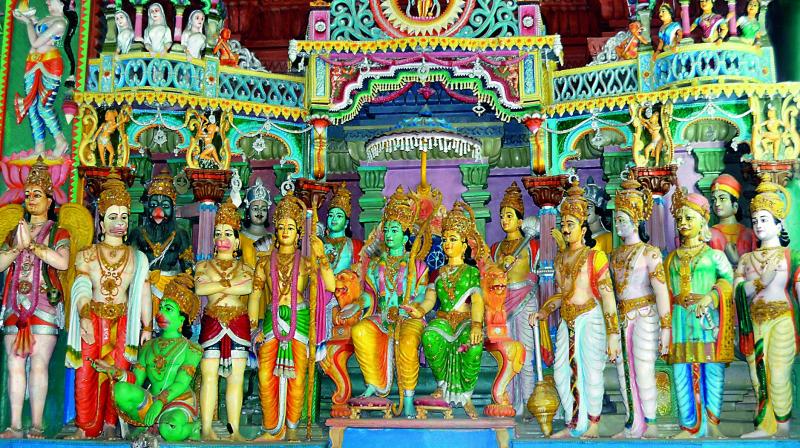Konaseema Ayodhya Rama beckons

Hyderabad: The Sri Kodandarama temple at Golla Mamidada, in Pedapudi mandal of East Godavari district, 20 km from Kakinada, is a must-see. It is situated in the village named Mamidada, probably because of the mango plantations around. Some say it was earlier known as Mamidi Vatika (mango garden). This small village is home to what is also known as “Konaseema Ayodhya”.
Situated on the main road from Kakinada to Bikkavolu, the temple always draws a huge crowd. The road also connects to Rajahmundry and Samarlakota.
The temple, following the tenets of Vaishnava Sampradaya, is on the banks of the river Thulya Bhaga (Antharvahini), a tributary of the Godavari. With mango and coconut trees and its two beautiful gopurams, this temple is very imposing and beautiful. The village is colloquially known as Gopurala Mamidada also because of the two huge gopurams. The temple is home to the idols of Lord Rama, Sita and Lakshmana. Since the celestial wedding of Lord Rama and Sita is performed in April on a grand scale, it is also called Chinna Bhadradi or the little Bhadrachalam.
While the scenery around the temple is picturesque, the temple architecture leaves the worshippers in awe. As in most cases, the temple land has been usurped. In many temples in AP, land parcels have been given elsewhere and so the temple per se does not have much land, allowing people to build freely. This temple was originally built on 16 acres, much of which has been lost.
The two stunningly beautiful gopurams are the main architectural attraction of the temple. Built in 1948, the east gopuram is 160-ft-high with nine storeys and five kalasams. The west gopuram, built in 1956, stands 210 feet and has 11 storeys and five kalasams. The works on the gopurams are very elegant and detailed. Someone has taken the trouble to inscribe stories from the Ramayana, Mahabharata and the Bhagavata Purana on these gopurams. It also symbolises the Sanjeevani Ghattam, Sundara Kanda and have navagrahas and Parvathi Parameswara idols.
The temple architecture showcases the skill of the Vishwakarma sthapathis. One can see beautiful stories in the form of idols from the four sides of the gopuram in each floor. If you have the stamina and patience, you can go up to the top storey which is a 300-step climb. The view, of course, would be incredible when you are able to catch your breath.
In 1975, an addala (mirror) mandapam was built between the two mandapams and practically above the sanctum sanctorum. The mirrored room is 120-ft-long, 60-ft-wide and 18-ft-high. There is a beautiful stucco relief of the Sri Rama Pattabhishekam on one side and on the other is Sri Rama blessing Lord Anjeneya. Because of the mirrors, the lord appears in all corners of the room and excites children a lot. Within the garbhalayam one can see Anjaneya sametha Sri Sita Rama Lakshmana.
The temple was established by vegetable vendors Dwarampudi Subbi Reddy and Rami Reddy on five acres of land in 1889. With a special love for Lord Rama, they would keep aside some money from daily earnings and built a small temple with wooden idols of Lord Rama and Sita Devi.
Sri Ranganathacharyalu, the third generation priest, says while this is a 135-year-old temple, the idol of the lord is swayambhu. A philanthropist of this village, Kovvuri Basivi Reddy, took over the temple in 1920 and the idols of Lord Rama, Sita and Laxmana were sanctified in 1934 and Lord Anjaneya in 1967. It was managed by his family till it was taken over by the endowments department in 1991.
The name Kodandarama suggests that that Lord Rama stands with a bow and arrow and is ready to fight. When it is Sitaramaswamy, Rama and Sita are in the sitting posture. Devotees make vows to return to the temple once their wishes are fulfilled.
The AP government is planning to develop the temple on the lines of the Sri Ramachandraswamy temple at Bhadrachalam and make it a second Bhadradri. Presently, it is among the important temples of Lord Rama in AP with Bhadrachalam going to Telangana state.

